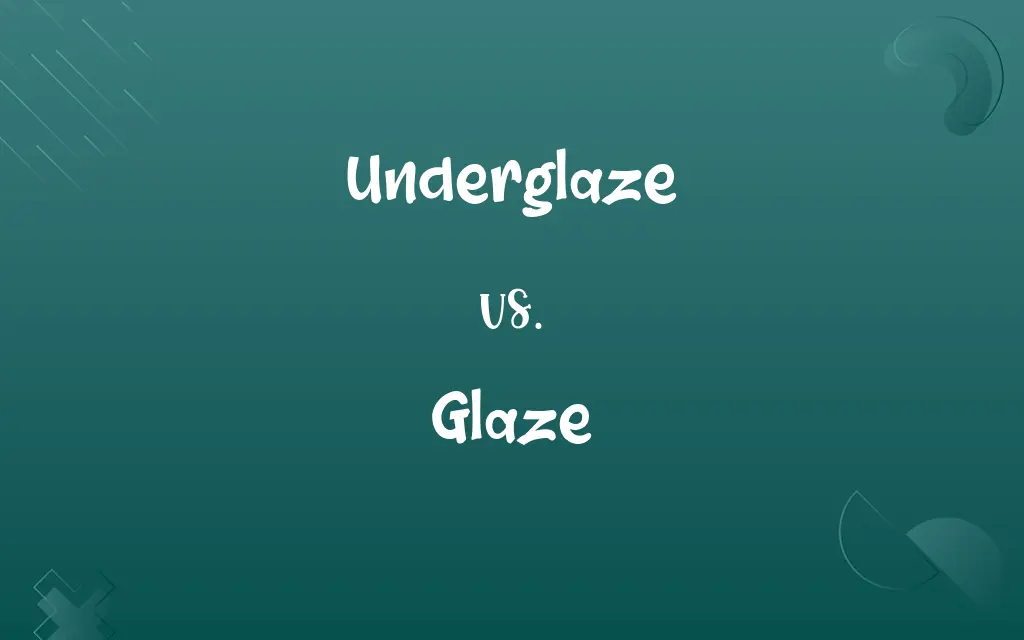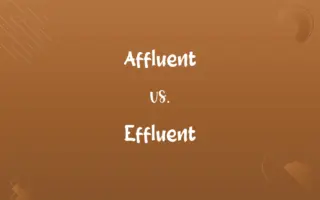Underglaze vs. Glaze: Know the Difference

By Dua Fatima & Shumaila Saeed || Published on May 7, 2024
Underglaze is applied to pottery before its first firing and is covered by a glaze, while glaze is a glassy coating fired at high temperatures for waterproofing and decoration.

Key Differences
Underglaze is a method of decoration applied to pottery or ceramics before they undergo their first firing. It's used to create designs that sit underneath a transparent or semi-transparent glaze. This technique allows for intricate details and colors to be preserved and protected by the subsequent glaze application. In contrast, glaze is applied over bisque-fired ceramics and undergoes a second firing. The glaze serves both decorative and functional purposes, adding color, texture, and waterproofing to the piece.
Shumaila Saeed
May 07, 2024
Glazes can vary greatly in their composition and appearance, ranging from glossy to matte finishes, and can be transparent, translucent, or opaque. They interact with the surface of the clay body and can alter the appearance of the underglaze beneath them. Underglazes, on the other hand, are formulated to show true color after firing, regardless of the glaze applied over them. This property makes underglazes particularly valuable for detailed artistic work.
Shumaila Saeed
May 07, 2024
The application of underglaze and glaze is also distinct. Underglazes are often applied to greenware (unfired clay), allowing for easier manipulation of detailed designs. Glazes are typically applied to bisque ware (clay that has been fired once without glaze) to ensure that the glaze adheres properly and achieves a uniform surface after the final firing.
Dua Fatima
May 07, 2024
The firing temperatures for underglazes and glazes can also differ. While underglazes must be compatible with the subsequent glaze firing temperature, glazes require specific firing ranges to mature properly. This difference necessitates careful selection of underglazes and glazes to ensure compatibility and achieve the desired visual effects.
Dua Fatima
May 07, 2024
Finally, the choice between using underglaze, glaze, or a combination of both depends on the desired artistic effect and functionality of the ceramic piece. While underglazes offer precision in design and color, glazes provide the essential protective layer and can significantly influence the final aesthetic through their texture, sheen, and color.
Shumaila Saeed
May 07, 2024
ADVERTISEMENT
Comparison Chart
Application Stage
Applied to greenware before the first firing.
Applied over bisque ware for the second firing.
Dua Fatima
May 07, 2024
Purpose
Decoration beneath the glaze, adds color and detail.
Provides waterproofing, adds color, and affects texture.
Shumaila Saeed
May 07, 2024
Finish
Matte and absorbs glaze applied over it.
Ranges from glossy to matte; can be transparent to opaque.
Shumaila Saeed
May 07, 2024
Firing Temperature
Must match the glaze's firing temperature.
Specific to the glaze's formulation for maturity.
Hifza Nasir
May 07, 2024
Interaction with Clay
Designed to show true color after firing.
Can alter appearance of clay and underglaze beneath.
Dua Fatima
May 07, 2024
ADVERTISEMENT
Underglaze and Glaze Definitions
Underglaze
A colored decoration applied on ceramics before glazing.
The potter painted a landscape with underglaze on the vase.
Dua Fatima
Feb 29, 2024
Glaze
Used to waterproof and finish ceramic items.
She dipped the pot in glaze to prepare it for its final firing.
Shumaila Saeed
Feb 29, 2024
Underglaze
A substance used to create detailed artwork on pottery.
She used blue underglaze for the intricate patterns.
Dua Fatima
Feb 29, 2024
Glaze
Can be glossy, matte, or satin in finish.
He chose a matte glaze to complement the rustic design.
Dua Fatima
Feb 29, 2024
Underglaze
Requires a covering glaze to be waterproof.
After decorating with underglaze, he covered it with a clear glaze.
Shumaila Saeed
Feb 29, 2024
ADVERTISEMENT
Glaze
Applied over bisque ware and refired.
After the bisque firing, the vase was ready for glazing.
Shumaila Saeed
Feb 29, 2024
Underglaze
Suitable for precise design work on ceramics.
Underglaze is perfect for the detailed floral motifs.
Hifza Nasir
Feb 29, 2024
Glaze
Affects the texture and color of the ceramic surface.
The red glaze turned orange on the high-fired clay.
Dua Fatima
Feb 29, 2024
Underglaze
Applied to greenware for artistic designs.
The underglaze was carefully applied to the unfired mug.
Dua Fatima
Feb 29, 2024
Glaze
To incrust, cover, or overlay with a thin surface, consisting of, or resembling, glass; as, to glaze earthenware; hence, to render smooth, glasslike, or glossy; as, to glaze paper, gunpowder, and the like.
Sorrow's eye glazed with blinding tears.
Dua Fatima
Feb 27, 2024
Glaze
A transparent coating applied to the surface of a painting to modify the color tones.
Shumaila Saeed
Feb 27, 2024
Underglaze
To apply a decorative slip to the surface of pottery before glazing.
Dua Fatima
Feb 27, 2024
Glaze
To apply thinly a transparent or semitransparent color to (another color), to modify the effect.
Dua Fatima
Feb 27, 2024
Underglaze
Applied under the glaze, that is, before the glaze is put on; fitted to be so applied; - said of colors in porcelain painting.
Dua Fatima
Feb 27, 2024
Glaze
(ceramics) The vitreous coating of pottery or porcelain; anything used as a coating or color in glazing. See glaze (transitive verb).
Dua Fatima
Feb 27, 2024
Glaze
A coating of colored, opaque, or transparent material applied to ceramics before firing.
Dua Fatima
Feb 27, 2024
Glaze
(meteorology) A smooth coating of ice formed on objects due to the freezing of rain; glaze ice.
Shumaila Saeed
Feb 27, 2024
Glaze
To furnish (a window, a house, a sash, a case, etc.) with glass.
Two cabinets daintily paved, richly handed, and glazed with crystalline glass.
Dua Fatima
Feb 27, 2024
Glaze
A glassy coating applied on pottery for decoration and sealing.
The glaze gave the bowl a glossy finish.
Dua Fatima
Feb 29, 2024
Repeatedly Asked Queries
What is underglaze?
Underglaze is a colored decoration applied to pottery before it is glazed and fired, allowing for detailed designs beneath a protective coating.
Shumaila Saeed
May 07, 2024
Do you apply glaze to greenware or bisque ware?
Glaze is applied to bisque ware, pottery that has been fired once without glaze, to ensure proper adhesion and finish after the final firing.
Shumaila Saeed
May 07, 2024
What's the difference in firing temperature between underglaze and glaze?
Underglaze must be compatible with the glaze's firing temperature, while glazes have specific firing ranges to mature properly.
Shumaila Saeed
May 07, 2024
What is glaze?
Glaze is a glassy coating applied over ceramics, providing waterproofing, decoration, and a finish ranging from glossy to matte.
Shumaila Saeed
May 07, 2024
How do underglaze and glaze contribute to the waterproofing of ceramics?
Underglaze provides color and design beneath the glaze, which is the main component that seals the pottery, making it waterproof.
Shumaila Saeed
May 07, 2024
Can underglaze change color after firing?
Underglazes are formulated to retain their color after firing, but the final appearance can be influenced by the covering glaze and firing conditions.
Dua Fatima
May 07, 2024
Can underglaze be applied over glaze?
Typically, underglaze is applied before glaze, as it's designed to be covered by glaze for protection and to achieve the desired aesthetic.
Dua Fatima
May 07, 2024
Can glaze be applied without underglaze?
Yes, glaze can be applied on its own to provide a finish and waterproofing to ceramics without the need for underglaze.
Dua Fatima
May 07, 2024
How does the finish of glaze compare to underglaze?
Glaze finishes range from glossy to matte and can be transparent to opaque, while underglaze typically has a matte finish that is covered by glaze.
Shumaila Saeed
May 07, 2024
Can glaze alter the color of underglaze?
Yes, the glaze can change the appearance of the underglaze beneath it, depending on its transparency and the interaction between the materials during firing.
Hifza Nasir
May 07, 2024
How do you choose the right glaze for a piece with underglaze?
Choose a glaze that is compatible with the underglaze's firing temperature and desired aesthetic, considering finish, transparency, and color interaction.
Dua Fatima
May 07, 2024
Is underglaze necessary for all ceramic pieces?
No, underglaze is optional and used for adding detailed designs or colors beneath the glaze.
Dua Fatima
May 07, 2024
What types of ceramics are best suited for underglaze decoration?
Ceramics that require detailed, colorful designs beneath a protective glaze are best suited for underglaze decoration.
Dua Fatima
May 07, 2024
Can underglaze be used on its own without a covering glaze?
While underglaze can be left unglazed, it typically requires a covering glaze to be waterproof and for the design to be preserved.
Dua Fatima
May 07, 2024
Share this page
Link for your blog / website
HTML
Link to share via messenger
About Author
Written by
Dua FatimaCo-written by
Shumaila SaeedShumaila Saeed, an expert content creator with 6 years of experience, specializes in distilling complex topics into easily digestible comparisons, shining a light on the nuances that both inform and educate readers with clarity and accuracy.









































































